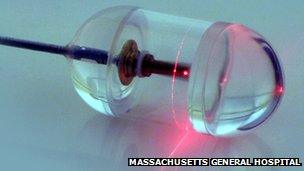Pill-sized scanner images gullet
- Published

Doctors have made a pill-sized device that can take detailed microscopic images of inside the gullet.
It is hoped the US technology could become an easier way of screening people for a condition called Barrett's oesophagus, which can lead to cancer.
Unlike current imaging techniques, the device can be used while the patient is conscious and takes only a few minutes.
The device has been tested in a small number of patients so far, Nature Medicine reports.
Although researchers at Wellman Center for Photomedicine at Massachusetts General Hospital in Boston say the device has potentially wide application, it could be particularly useful for Barrett's oesophagus where many people do not realise they have it, but there is no easy way to screen for it.
In those with the condition, the cells in the lower gullet become abnormal due to chronic acid reflux, which puts them at a higher risk of developing cancer of the oesophagus.
Doctors can screen those at risk using an endoscope - a flexible tube containing a tiny video camera - but this is unpleasant and usually has to be done under sedation.
Tiny capsule
The new device is contained in a capsule about the size of a multivitamin pill connected by a thin wire.
Within the capsule is a rapidly rotating laser tip which emits infrared light that is then reflected back from the lining of the oesophagus.
The image doctors see on the screen is a 3D landscape showing far more microscopic detail than can be seen with endoscopy.
When the patient swallows the capsule it is carried down the oesophagus in the same way any piece of food would be then once it reaches the stomach it can be pulled back out using the wire.
Images are taken the whole time the device is moving up and down the gullet and the whole process takes a matter of minutes.
Testing the equipment in six patients known to have Barrett's oesophagus and seven healthy volunteers, the researchers said the images clearly showed the cellular changes that occur in those with the condition.
'Best pictures'
Prof Gary Tearney, one of the research collaborators, said the technology is cheaper than endoscopy and avoids the need for sedation, specialised equipment or special training.
And the microscopic detail shown in the images means a biopsy can be avoided.
"The images produced have been some of the best we have seen of the oesophagus," says Prof Tearne, a professor of pathology at Harvard Medical School.
"We originally were concerned that we might miss a lot of data because of the small size of the capsule, but we were surprised to find that, once the pill has been swallowed, it is firmly 'grasped' by the oesophagus, allowing complete microscopic imaging of the entire wall."
Prof Tearney added that the device could help doctors work out who is at risk and detect cancers at potentially more treatable stage.
Prof Rebecca Fitzgerald, a specialist on Barrett's oesophagus at the Cambridge Cancer Centre, said: "It is elegant technology. The downside is that you will have to endoscope anyone with suspected Barrett's as you will have no way of sampling and detecting dysplasia [abnormalities] with this technology."
- Published4 June 2011
- Published28 August 2010
- Published30 August 2012